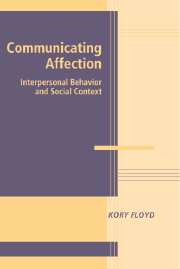Book contents
- Frontmatter
- Contents
- List of Tables
- List of Figures
- Foreword
- 1 AN INTRODUCTION TO AFFECTIONATE COMMUNICATION
- 2 THINKING ABOUT AFFECTION: THE THEORIES
- 3 ENCODING AFFECTIONATE MESSAGES
- 4 DECODING AND RESPONDING TO AFFECTIONATE EXPRESSIONS
- 5 BENEFITS OF EXPRESSING AND RECEIVING AFFECTION
- 6 RISKS ASSOCIATED WITH AFFECTIONATE COMMUNICATION
- 7 A NEW THEORETIC APPROACH
- 8 AFFECTIONATE COMMUNICATION IN HUMAN INTERACTION
- References
- Index
8 - AFFECTIONATE COMMUNICATION IN HUMAN INTERACTION
Published online by Cambridge University Press: 02 December 2009
- Frontmatter
- Contents
- List of Tables
- List of Figures
- Foreword
- 1 AN INTRODUCTION TO AFFECTIONATE COMMUNICATION
- 2 THINKING ABOUT AFFECTION: THE THEORIES
- 3 ENCODING AFFECTIONATE MESSAGES
- 4 DECODING AND RESPONDING TO AFFECTIONATE EXPRESSIONS
- 5 BENEFITS OF EXPRESSING AND RECEIVING AFFECTION
- 6 RISKS ASSOCIATED WITH AFFECTIONATE COMMUNICATION
- 7 A NEW THEORETIC APPROACH
- 8 AFFECTIONATE COMMUNICATION IN HUMAN INTERACTION
- References
- Index
Summary
We can live without religion and meditation, but we cannot survive without human affection.
– Dalai LamaThe preceding chapters have examined multiple aspects of the expression and exchange of affectionate communication in human interaction. Several theoretic treatments of affectionate behavior have been described and critiqued, and a large body of empirical findings has been synthesized around several fundamental questions concerning why, how, to whom, and with what effects people convey affection to each other. The body of research on affectionate communication is indeed eclectic in terms of its focus, its methodology, and its theoretic underpinnings. Although eclecticism serves the purposes of ensuring that diverse ideas are considered and that observed patterns are not conceptually or operationally bound, it can have the additional effect of making the literature appear not to support any general conclusions.
Such is not the case with affectionate communication, however. To bring this volume to a close, I have elected to identify and discuss what I believe are the most important observations about affectionate communication that have found support in the empirical literature. Although some of these conclusions are relatively intuitive, others are not; the fact that the body of research supports both types of conclusion is, I believe, testament to the provocative and often paradoxical nature of human affectionate communication.
- Type
- Chapter
- Information
- Communicating AffectionInterpersonal Behavior and Social Context, pp. 185 - 194Publisher: Cambridge University PressPrint publication year: 2006

